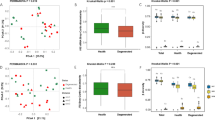Abstract
We studied the effects of earthworms, termites, ants, and millipedes on the dissemination of vesciulararbuscular mycorrhizal (VAM) propagules. Earthworm (Lumbricus terrestris L.) casts collected from the garden were air-dried, stored, and examined for the presence of VAM fungi by inoculating the cast material onto onion plants grown in sterilized soil. VAM propagules survived for a period of 12 months. The results showed that earth-worms can contribute to the dissemination of VAM propagules. Nests of ants (Camponotus compressus Fabr.) collected from different locations were examined for the presence of VAM propagules. They harboured up to 790 infective propagules g-1 of nest, showing that ants can be potential vectors in disseminating VAM fungi. The faecal pellets of the millipede (Phyllogonostreptus nigrolabiatus Newport) collected from the rearing tank were tested for VAM colonization. Though VAM propagules were present in the fresh faecal pellets, they lost their viability after 4 days of storage. Termitaria samples of both mound-building and subterranean termites were also examined for VAM propagules but those found were non-viable.
Similar content being viewed by others
References
Bagyaraj DJ (1991) Ecology of VA mycorrhizae. In: Arora DK, Bharat Rai, Mukherji KG, Knudsen G (eds) Handbook of applied mycology. Vol I. Soil and plants. Marcel Dekker, New York, NY, pp 1–34
Bagyaraj DJ (1992) Vesicular arbuscular mycorrhiza: Applcation in agriculture. In: Norris JR, Read DJ, Verma AK (eds) Methods in microbiology, 24. Academic Press, London, pp 359–374
Bano K, Bagyaraj DJ, Krishnamurthy RV (1976) Feeding activity of millipede Jonospeltis splendidus Verhoff and soil humification. Proc Indian Acad Sci 82: 1–11
Baxter FP, Hole FP (1966) The ant that ploughed the prairie. Crop Soils 19: 11–13
Deligne J, Quennedey A, Bhim HS (1991) The enemies and defence mechanisms of termites. In: Hermon HR (ed) Social insects, vol II. Academic Press, London, pp 1–76
Gerdemann JW, Nicolson TJ (1963) Spores of mycorrhizal Endogone species extracted from soil by wet sieving and decantation. Trans Br Mycol Soc 46: 235–244
Harinikumar RM, Bagyarai DJ (1991) Do wasps disperse vesicular arbuscular mycorrhizal fungi? In: Bagyaraj DJ, Manjunath A (eds) Mycorrhizal symbiosis and plant growth. Reproduction, Bangalore, pp 14–15
Harinikumar KM, Bagyaraj DJ, Kale RD (1991) Vesicular arbuscular mycorrhizal propagules in earthworm casts. In: Veeresh GK, Rajagopal D, Viraktamath CV (ed) Advances in management and conservation of soil fauna. Oxford and IBH Publ Co, New Delhi, pp 605–610
Hetrick BDA (1984) Ecology of VA mycorrhizal fungi. In: Powell CL, Bagyaraj DJ (eds) VA mycorrhiza. CRC Press, Boca Raton, Fla, pp 35–55
Jeffries P (1987) Use of myorrhizas in agriculture. CRC Crit Rev Biotechnol 5: 319–357
Kale RD, Krishnamurthy RV (1981) Litter preferences in the earthworm Lampito mauritii. Proc Indian Acad Sci 90: 123–128
MacMohan JA, Warner A (1984) Dispersal of mycorrhizal fungi: Processes and agents. In: Williams SE, Allen MF (eds) VA mycorrhizae and reclamation of arid and semiarid lands. University of Wyoming Publ, pp 24–41
McIlveen MP, Cole H Jr (1976) Spore dispersal Endogonaceae by worms, ants, wasps and birds. Can J Bot 84: 1486–1489
Phillips JM, Hayman DS (1970) Improved procedures for cleaning roots and staining parasitic and vesicular arbuscular mycorrhizal fungi for rapid assessment of infection. Trans Br Mycol Soc 55: 158–161
Porter WM (1979) The most probable number method for enumerating infective propagules of vesicular arbuscular mycorrhizal fungi in soil. Aust J Soil Res 17: 515–519
Powell CL (1976) Development of mycorrhizal infections from endogone spore and infected root segments. Trans Br Mycol Soc 66: 439–445
Thaxter R (1922) A revision of the Endogonaceae. Proc Am Acad Sci 57: 291–351
Tommerup IC, Carter CJ (1982) Dry separation of microorganisms from soil. Soil Biol Biochem 14: 69–71
Author information
Authors and Affiliations
Rights and permissions
About this article
Cite this article
Harinikumar, K.M., Bagyaraj, D.J. Potential of earthworms, ants, millipedes, and termites for dissemination of vesicular-arbuscular mycorrhizal fungi in soil. Biol Fert Soils 18, 115–118 (1994). https://doi.org/10.1007/BF00336456
Received:
Issue Date:
DOI: https://doi.org/10.1007/BF00336456




